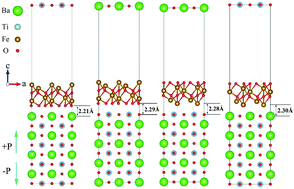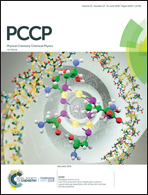Tuning the magnetism of two-dimensional hematene by ferroelectric polarization†
Abstract
Magnetism in two-dimensional (2D) materials, that is, a 2D version of the magnetism of three-dimensional bulk materials, and the associated novel physics have recently been the focus of many spintronics researchers. Here we investigate the manipulation of 2D magnetism at the interfaces of ferromagnetic/ferroelectric hematene/BaTiO3(001) heterostructures (HSs) fabricated via a precisely chosen sequence. By introducing four types of interfaces of 2D hematene and three-dimensional BaTiO3 that induce different oxygen environments, the control of magnetism is directly demonstrated from first-principles. An obvious 2D electron gas originates from the Fe-3d and O-2p hybridization; the electron gas is sensitive to the interfacial atomic displacements. Robust control of both the direction and magnitude of the net magnetization has been realized for an Fe/TiO2 terminated bilayer HS. The electron occupancies of the dxy and dxz orbitals and changes to the Fe–O bond play a key role in determining the magnetism of our systems. Our work not only demonstrates the technique's potential for manipulating magnetism in 2D hematene, but also sheds light on the underlying mechanism and the fundamental properties of hematene HSs.



 Please wait while we load your content...
Please wait while we load your content...